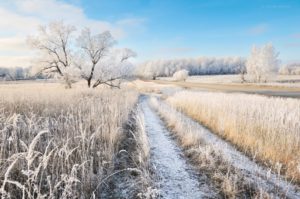Aleksandr Kukrinov:
Winter is definitely an exciting time for the photographer. Despite the apparent poverty of colours, you can find quite a few interesting plots for shooting. The unique mood of the winter nature is definitely worth of attention. You have a little left to do with it, i.e. to perpetuate this beauty with high quality and in interesting manner.
1. The first snow
The time when autumn meets winter is unique, do not miss it! Autumn accents in the winter surroundings create a special mood of the completion of one life phase and the beginning of the new one. Here, you should also have a high-aperture lens to prevent your accents be merged with the background and to focus on those accents.
Camera: Nikon D810
Diaphragm: f/2.8
Exposure: 1/320
ISO: 200
Focal length: 100 мм
2. Afternoon photography
Thanks to the fact that the winter sun is not that bright like in summer, you can shoot in daylight without fear that the camera lacks dynamic range to display information in the highlights and shadows, especially if you shoot in RAW format. Bright, sunny winter pictures will beautify your portfolio, for sure.
Camera: Nikon D3s
Lens: AF-S NIKKOR 24-70mm f/2.8G ED
Diaphragm: f/8
Exposure: 1/400
ISO: 200
Focal length: 24 мм
But, anyway, my priority is snapshots in the evening and morning hours. Upon the onset of frosts, in the performance time, you can see an incredibly beautiful palette in the sky. Blue, pink, purple, orange shades adorn the frosty sky and are just asking to be shot. 🙂
Camera: Nikon D3s
Lens: AF-S NIKKOR 16-35mm f/4G ED
Diaphragm: f/10
Exposure: 1/20
ISO: 200
Focal length: 35 мм
3. White balance
You may also want to experiment with the white balance. In particular, when taking the photos of the evening city, I set the automatic mode for around 6,000 Kelvin. By shifting the WB to the warmer 8,000, I got more believable and, in my opinion, more delicious shades for this story.
Camera: Nikon D3s
Lens: AF-S NIKKOR 24-70mm f/2.8G ED
Diaphragm: f/10
Exposure: 15
ISO: 100
Focal length: 52 мм
4. Shooting the snow
It is undeniable that the falling snow gives artistic touch to the photos. It is necessary to remember the following: in the absence of additional illumination (during daylight hours), longer focal length displays the snow better. Therefore, if you want to see it on your photos, try to select scenes for long-focus camera lenses. In this case, a more beneficial background will be a darker one (in the picture below and in the first picture the snow intensity is almost the same, the FL is 100 and 300 mm, respectively). Do not also forget that the snow moves; its form in the picture will depend on the exposure time: short exposure time will turn it into points, longer times will show it in strips. Both variants are of interest. All depends on the artistic tasks. You are the one to choose.
Camera: Nikon D3s
Lens: AF-S NIKKOR 28-300mm f/3.5-5.6G ED VR
Diaphragm: f/5.6
Exposure: 1/800
ISO: 800
Focal length: 300 мм
To photograph a snowfall in the evening city, choose a shooting point directly near the street lamp. It will illuminate the falling snow in the foreground and display it wonderfully in the photo.
Camera: Nikon D3s
Lens: AF-S NIKKOR 16-35mm f/4G ED
Diaphragm: f/4
Exposure: 1/15
ISO: 640
Focal length: 25 мм
I wish all to take marvellous pictures!











